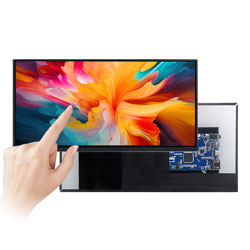- sales/support
Google Chat: zj734465502@gmail.com
- sales
+86-0755-88291180
- sales01
sales@spotpear.com
- sales02
dragon_manager@163.com
- support
tech-support@spotpear.com
- CEO-Complaints
zhoujie@spotpear.com
- sales/support
WhatsApp:13246739196
11.6inch-1768x828-LCD User Guide
Features
- 11.6-inch IPS screen with 1768x828 hardware resolution.
- 10-point capacitive touch with in-cell touch technique, narrow frame with thin thickness, fast response.
- Supports Raspberry Pi OS/Ubuntu/Kali and Retropie when used with Raspberry Pi.
- Supports Windows 11/10/8.1/8/7 when used as a computer monitor.
- Supports Ubuntu when working with Jetson series.
- Multi-language OSD menu support (can be used for power control, adjusting brightness/contrast, etc.)
- Support software DDC/CI brightness adjustment.
Specification
| Item | Description | Unit |
|---|---|---|
| Model | 11.6inch 1768x828 LCD | / |
| Size | 11.6 | Inch |
| Viewing Angle | 178 | Deg |
| Resolution | 1768x828 | Pixels |
| Overall Dimensions | 276.70(H)×139.10(V)×14.17(D) | mm |
| Display Area | 270.20(H)×127.20(V) | mm |
| Color Gamut | 72% | NTSC |
| Maximum Brightness | 300 | cd/m² |
| Contrast | 1200:1 | / |
| Backlight Adjustment | OSD menu/DDCCI brightness adjustment | / |
| Refresh Rate | 60 | Hz |
| Display Interface | HDMI/Type-C | / |
| Power Port | 5V Power Supply | / |
| Maximum Power Consumption | 5 | Watt |
Electrical Parameters
| Parameter | Min. Value | Standard Value | Max. Value | Unit | Note |
|---|---|---|---|---|---|
| Input Voltage | 4.75 | 5.00 | 5.25 | V | Note 1 |
| Input Current | 1 | 1 | TBD | A | Note 2 |
| Operating Temperature | 0 | 25 | 60 | ℃ | Note 3 |
| Storage Temperature | -10 | 25 | 70 | ℃ | Note 3 |
•Note 1: Input voltage exceeding the maximum value or improper operation may cause permanent damage to the device.
•Note 2: The input current should be ≥1A, otherwise, it will lead to start-up failure or abnormal display, and a long time in an abnormal state may cause permanent damage to the device.
•Note 3: Please do not put the display in a high-temperature and high-humidity storage environment for a long time, the display needs to work within the limit value, otherwise it will be possible to damage the display.
Onboard Interface
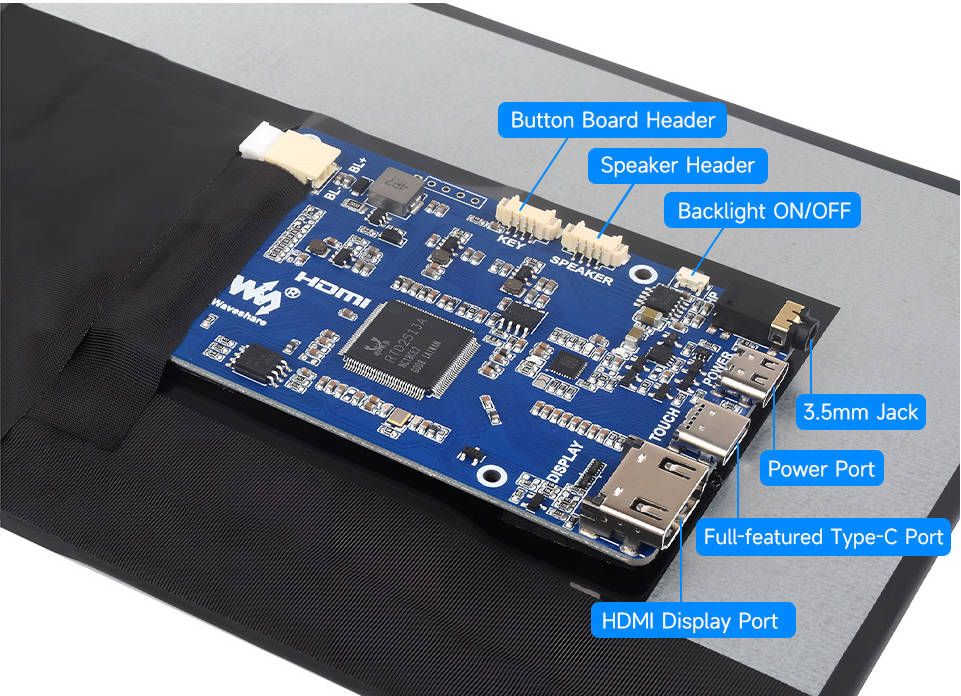
User Guide
Working with PC
Support Windows 11/10/8.1/8/7
HDMI/DP Interface Display
- Connect 5V power adapter to the DC port of the screen.
- Connect the Touch interface of the LCD to the USB port of the PC, Windows will automatically identify the touch function.
- Connect the LCD to the PC through the HDMI interface, Windows will automatically identify the display function.
- Note:
- Some PC may not support the plug-and-play function of HDMI/DP devices, and it could be normally used after rebooting the system.
- If the 5V power supply is insufficient, the LCD will blink. It is recommended to use the matched 5V 3A power adapter or manually lower the brightness.

Type-C Interface Display
- Connect the 5V power supply to the DC power port of the screen.
- Use USB-C to USB-C cable to connect the Touch interface of the LCD to the full-featured Type-C interface of PC. Windows will automatically identify touch and display function.
- Note:
- The host device must boast the full-feature Type-C interface so that the Type-C can be connected to display.
- Some PC may not support the plug-and-play function of HDMI/DP devices, and it could be normally used after rebooting the system.
- If the 5V power supply is insufficient, the LCD will blink. It is recommended to use the matched 5V 3A power adapter or manually lower the brightness.
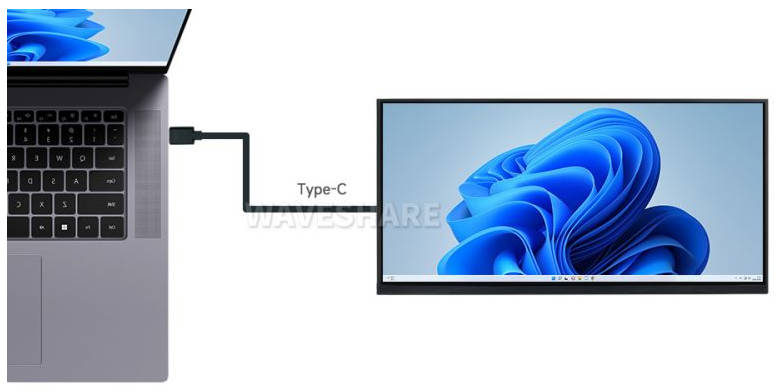
Windows Touch Calibration
Take Windows 10 as an example:
- 1. Enter the Windows setting of the system, type in the search bar, and click "Calibrate the screen for pen or touch input" (as shown in the picture below):
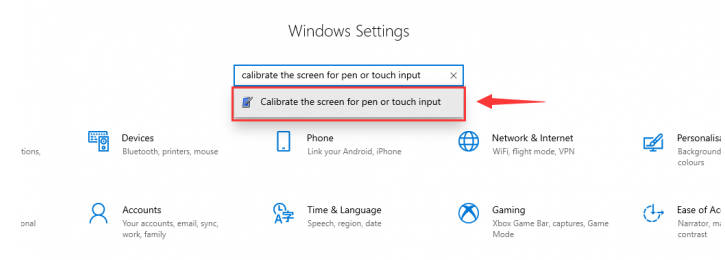
- 2. Click "Setup" in the pop-up "Tablet PC Settings" interface:
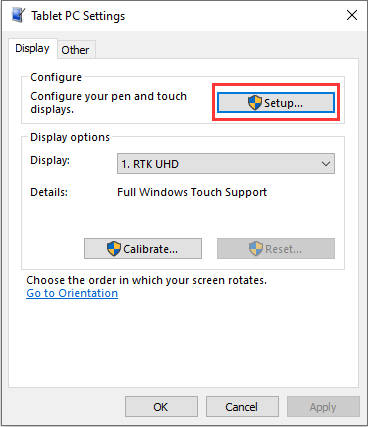
- 3. The following text prompt will appear on the screen. Please tap the touch screen with your finger, and the computer will recognize it as a touch screen.

Working with Raspberry Pi
Hardware Connection
- Connect the 5V power adapter to the DC power port of the screen.
- Connect the Touch interface of the LCD to the USB connector of the Raspberry Pi.
- Connect the HDMI interface of the LCD to the HDMI interface of the Raspberry Pi.
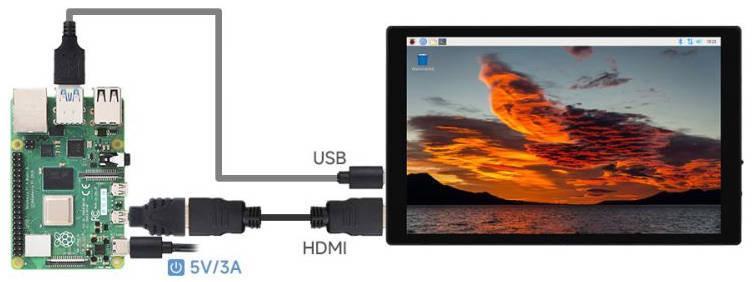
Software Setting
For Raspberry Pi OS/Ubuntu/Kali and Retropie systems.
- 1. Insert the TF card into the PC, download it, and use Raspberry Pi Imager to program the corresponding image.
- 2. After programming the image, open the "config.txt" file located in the root directory of the TF card. Add the following code at the end of config.txt, save the file, and safely eject the TF card.
hdmi_group=2
hdmi_mode=87
hdmi_timings=1768 0 80 16 204 828 0 9 6 28 0 0 0 60 0 108000000 0- 3. Insert the TF card into the Raspberry Pi, power on the Raspberry Pi, and wait for a few seconds. After the system boots up, you should be able to enter the display interface and the LCD should touch normally.
Display Rotation
If you are using a Bullseye/Buster system, you can rotate it as follows:
- 1. Go to Screen Configuration.

- 2. Rotate as shown below:
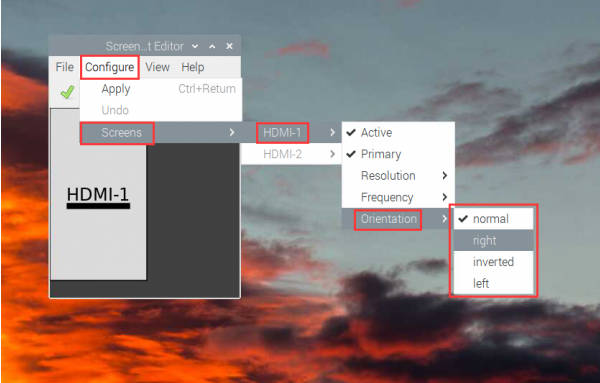
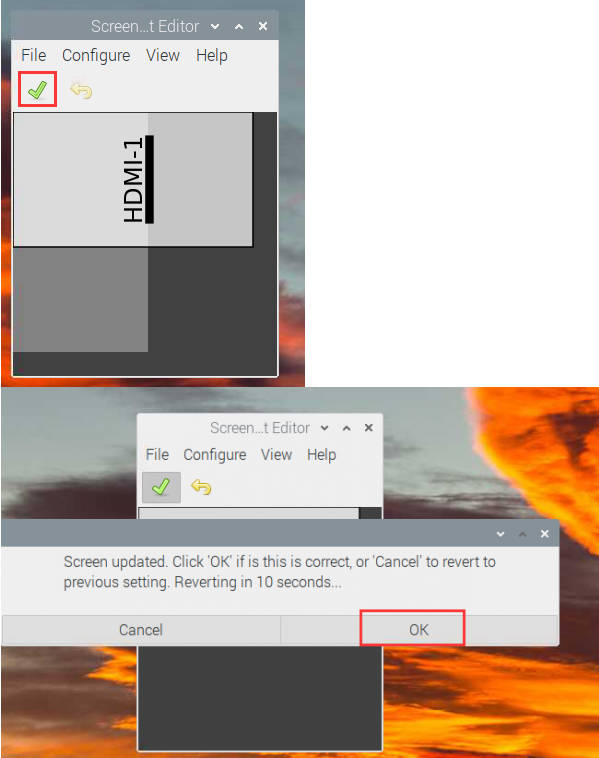
If you use other systems, you can rotate the display as shown below:
- 1. Add the following sentence in the config.txt file (the config file is located in the root directory of the TF card, or /boot):
display_rotate=1 #1:90;2: 180; 3: 270
- 2. Reboot the Raspberry Pi after saving.
sudo reboot
Touch Rotation
As the touch direction is different after rotating, you need to rotate the touch as shown below:
1. Install libinput
sudo apt-get install xserver-xorg-input-libinput
If the system you want to install is Ubuntu or Jetson Nano, the installation command is:
sudo apt install xserver-xorg-input-synaptics
2. Create xorg.conf.d directory in /etc/X11/. (If the directory exists, you can directly skip to Step 3.)
sudo mkdir /etc/X11/xorg.conf.d
3. Copy 40-libinput-conf file to the directory created just now.
sudo cp /usr/share/X11/xorg.conf.d/40-libinput.conf /etc/X11/xorg.conf.d/
4. Edit the file.
sudo nano /etc/X11/xorg.conf.d/40-libinput.conf
Find the touchscreen part, add the following sentence, and then save.
Option "CalibrationMatrix" "0 1 0 -1 0 1 0 0 1"
As shown below:
5. Reboot the Raspberry Pi.
sudo reboot
After finishing the above steps, the touch can be rotated 90 degrees.
Note:
90-degree rotation: Option "CalibrationMatrix" "0 1 0 -1 0 1 0 0 1"
180-degree rotation: Option "CalibrationMatrix" "-1 0 1 0 -1 1 0 0 1"
270-degree rotation: Option "CalibrationMatrix" "0 -1 1 1 0 0 0 0 1"
Set the Screen Always On
Some customers want to display without being affected by the screen saver function and can be set as follows. Turn off the screen saver.
Open lightdm.conf.
sudo nano /etc/lightdm/lightdm.conf
Change lightdm.conf to find "xserver-command" under the [SeatDefaults] section, uncomment it, and change it to read as follows:
#xserver-command=X
Modify to
xserver-command=X -s 0 -dpms
-s # –: Set the screen saver not to enable.
dpms: Disable power saving management.
Reboot:
sudo reboot
Set the Screen Off and On
Users can set the screen to turn off and on with the following commands.
vcgencmd display_power 0 vcgencmd display_power 1
Dimensions
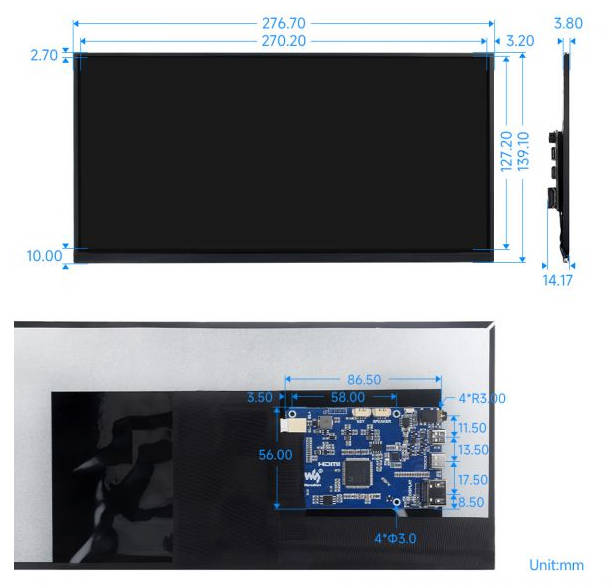
Support
Monday-Friday (9:30-6:30) Saturday (9:30-5:30)
Mobile: +86 13434470212
Email: services01@spotpear.com




